Coriander refers to both the seeds and the entire plant of Coriandrum sativum, an annual herb in the parsley family. What many people call cilantro in the Americas is actually the fresh leaves and stems of this same plant, while "coriander" typically refers to the dried seeds used as a spice. This dual naming causes frequent confusion, but botanically they come from one plant with distinct culinary applications.
Understanding what is the coriander requires recognizing its dual identity in global cuisine. The plant produces two distinct culinary products: the fresh green leaves known as cilantro in North America (but called coriander leaves in many other regions), and the round, tan seeds that become the spice we universally call coriander. This botanical reality explains why recipes might call for "coriander leaves" in some countries and "cilantro" in others while referring to the exact same ingredient.
Botanical Background of Coriander
Coriandrum sativum grows to about two feet tall with slender stems, triangular leaves, and small white or pink flowers that develop into the characteristic round seeds. Native to regions spanning Southern Europe, North Africa, and Southwest Asia, this versatile plant has been cultivated for over 7,000 years. Ancient Egyptians used coriander seeds as both food and medicine, with archaeological evidence showing their presence in pharaohs' tombs.

Coriander vs. Cilantro: Clearing the Confusion
The terminology difference between coriander and cilantro represents one of the most common points of confusion in international cooking. In most of the world, "coriander" refers to all parts of the plant. However, in the United States and Canada, "cilantro" specifically denotes the fresh leaves and stems, while "coriander" refers only to the dried seeds.
| Region | Leaves/Stems | Seeds |
|---|---|---|
| United States/Canada | Cilantro | Coriander |
| United Kingdom/Europe | Coriander leaves | Coriander seeds |
| India/Middle East | Dhaniya (leaves) | Dhaniya (seeds) |
Culinary Applications of Coriander
Chefs worldwide rely on coriander seeds uses in cooking for their warm, citrusy flavor with subtle floral notes. When toasted and ground, they form essential components in curry powders, pickling spices, and baked goods. The fresh leaves (cilantro) provide a bright, citrusy accent to salsas, chutneys, and Southeast Asian dishes.
Professional cooks often recommend how to use fresh coriander by adding the leaves at the end of cooking to preserve their delicate flavor. The seeds, however, benefit from toasting before grinding to release their essential oils. Many traditional recipes from Indian, Mexican, and Middle Eastern cuisines feature both components of the plant in different stages of preparation.
Nutritional Profile and Traditional Uses
Both forms of coriander offer nutritional benefits. The fresh leaves provide significant vitamin K, vitamin A, and vitamin C, while the seeds contain dietary fiber, iron, and manganese. Traditional medicine systems have used coriander for digestive support and as a natural preservative. Modern research continues investigating coriander nutritional benefits, particularly regarding antioxidant properties.
Practical Tips for Home Cooks
When working with this versatile herb, consider these practical suggestions:
- Store fresh coriander leaves like cut flowers—trim stems and place in water, covered with a plastic bag in the refrigerator
- Freeze whole coriander seeds in an airtight container for up to two years while maintaining flavor
- Create your own coriander spice substitute by combining cumin, caraway, and a touch of citrus zest when needed
- Grow coriander at home in containers—it thrives in cool weather and requires minimal care

Global Significance in Cuisine
Understanding what is coriander means recognizing its global culinary importance. From Indian dhania to Mexican cilantro, this single plant bridges culinary traditions worldwide. In Moroccan tagines, the seeds provide depth; in Vietnamese pho, the fresh leaves offer brightness; and in European sausages, ground coriander adds distinctive flavor. This universal appeal makes it one of the most widely used herbs and spices across diverse food cultures.











 浙公网安备
33010002000092号
浙公网安备
33010002000092号 浙B2-20120091-4
浙B2-20120091-4